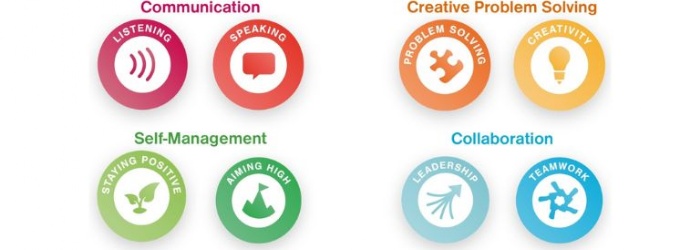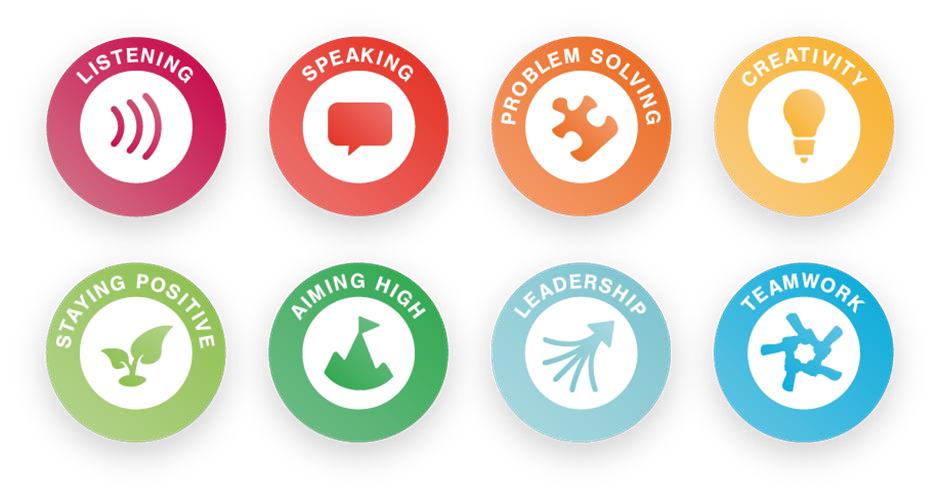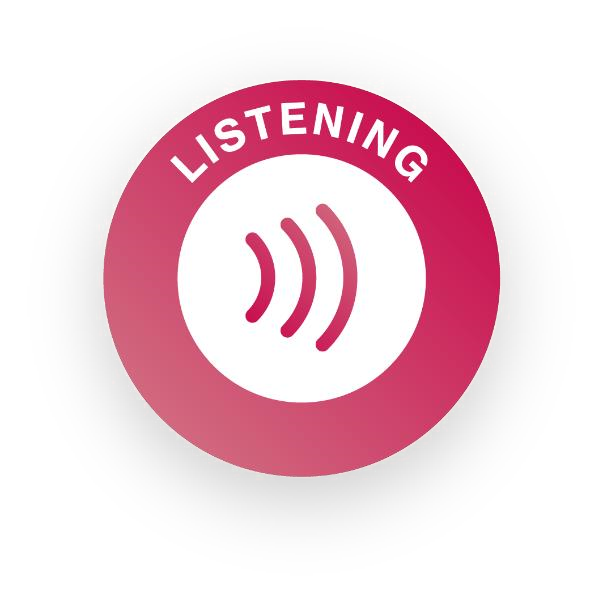Building Skills at Home: Parent and Carer Guide

Co-op Academy Princeville works with The Skills Builder Partnership to ensure every learner has opportunities to build eight essential skills to support them now and in the future.

Research has shown that building these eight essential skills can support the emotional wellbeing and academic success of children and young people, as well as preparing them for life beyond school.
Skills Builder has developed a Universal Framework that breaks each of these essential skills down into 16 teachable steps. We use this framework to teach and practise each of the eight skills at the appropriate level throughout school life.
Skills Builder has a resource platform dedicated to helping parents and carers to build their child’s essential skills at home: Skills Builder Homezone (skillsbuilder.org/homezone).
From Weekly Skill Challenges, to family activities and guidance to share with older children to access independent tools for their own skill development, Skills Builder Homezone can be enjoyed at a time and pace to suit all families.

The receiving, retaining and processing of information or ideas
This skill is all about being able to listen effectively to others.
Initially when developing this skill we focus on remembering short instructions, understanding why others are communicating and picking out important information.
We then look at how to demonstrate we are listening effectively, thinking about body language, open questioning and summarising and rephrasing.
Suggested activities to try at home to build the skill of Listening:
For younger children
Read a story together. Stop as you go to talk about what might happen next. When you have finished, talk about what happened in the story.
Dance together to ‘Heads, Shoulder, Knees and Toes’. Sing the song and encourage your child to listen carefully and copy the actions. Alternatively, teach your child any other song and dance routine that you know!
For older children
Listen to and review an audiobook or podcast. Talk or write about what was good about it and if you would recommend it to others.
Arrange a phone or video call with an older family member. Speak clearly and listen carefully to the other person in the conversation.
For more Skills Challenges to try at home, visit:
The oral transmission of information or ideas
This skill is all about how to communicate effectively with others.
Initially, this skill focuses on being able to speak clearly – first with a friend or someone we know well and in small groups, and then with those who are not known.
The next stage is about being an effective speaker by making points logically, by thinking about what listeners already know and using appropriate language, tone and gesture.
Suggested activities to try at home to build the skill of Speaking:
For younger children
Share nursery rhymes together. Take it in turns to speak and listen, speaking the words clearly so your child can copy.
Talk to wider family members. Help your child use the phone, videocalling apps or other platforms to contact family members for a chat. Talk to them beforehand to plan what they might ask, then talk again afterwards about what was said.
For older children
Plan a presentation about a hobby or interest. This might be about a computer game, a sport or a style of music. Ask questions to extend the conversation.
Put on a show for family. Organise a short show to run over a video call or in person to entertain family members. It could include a song, magic trick or a presentation. Introduce the show clearly so the family know what to expect.
For more Skills Challenges to try at home, visit:
The ability to find a solution to a situation or challenge
This skill focuses on how to solve problems, recognising that while part of Problem Solving is technical know-how and experience, there are also transferrable tools that individuals can develop and use.
The first steps focus on being able to follow instructions to complete tasks, seeking help and extra information if needed. The next stage focuses on being able to explore problems by creating and assessing different potential solutions. This includes more complex problems, without a simple technical solution.
Suggested activities to try at home to build the skill of Problem Solving:
For younger children
Play a simple board game. Read out the instructions to set up and then to play the game, one step at a time.
Follow a simple recipe. Read out, find and measure ingredients needed together. Talk through the recipe, following the instructions one step at a time.
For older children
Consider the problem: A village has a river flowing through it. Villagers need a bridge to get across the river. Draw a sketch of a bridge design. Use junk-modelling to build a model of the bridge.
Consider the problem: How can we improve the environment? Research to find out more about this problem. Create 3 solutions you could do at home or locally to address this problem. Write or sketch to show how your proposed solutions might help solve the problem, then share this with your household.
For more Skills Challenges to try at home, visit:
The use of imagination and the generation of new ideas
Creativity is the complement to Problem Solving, and is about generating innovations or ideas which can then be honed through the problem-solving process.
The first few steps focus on the individual’s confidence in imagining different situations and sharing their ideas.
The focus is then on generating ideas – using a clear brief, making improvements to something that already exists and combining concepts.
Suggested activities to try at home to build the skill of Creativity:
For younger children
Play ‘Let’s Pretend’. Encourage some role play using toys or dressing-up clothes. Use any theme that you know will capture their imagination!
Invent a helpful robot. What would it look like? What can it do to help people? Draw a picture or build a junk model of the new robot. Talk about it to others.
For older children
Fashion designer. Choose a theme, then create designs for a new outfit. The clothes could be inspired by some existing designs that you then adapt or could be completely new. Draw illustrations or create designs on the computer and talk about them to others at home.
Games Designer. Create a storyboard or play for a brand new computer game. Think about an existing game you enjoy then change the characters, setting and/or challenge to make it new. Talk about your ideas with someone at home.
For more Skills Challenges to try at home, visit:
The ability to use tactics and strategies to overcome setbacks and achieve goals
This skill is all about being equipped to manage emotions effectively and being able to remain motivated, and ultimately to motivate others, even when facing setbacks.
The early steps focus on identifying emotions – particularly feeling positive or negative. Building off that is the ability to keep trying – and then staying calm, thinking about what went wrong, and trying to cheer up and encourage others.
Suggested activities to try at home to build the skill of Staying Positive:
For younger children
Thumbs up, thumbs down. Talk about different feelings and identify which are positive emotions (thumbs are up) and which are negative emotions (thumbs down). Discuss how you are feeling at different points of the day.
Build a tall tower. Work together to build the tallest tower you can with toy bricks, Lego or anything other suitable construction materials. When it falls down, talk about how you feel and try again to build it even taller.
For older children
Play a tricky game. Play a computer or board game that you know is tricky, but is still fun! Talk about when things go wrong, or you are losing. Talk about how you feel and what you need to do to stay calm and carry on. Encourage each other to keep going.
Master something new. Think of an activity that requires practice and set it as a challenge. Could be to learn a new language, how to juggle, to play a new song on an instrument or to do a new magic trick!
For more Skills Challenges to try at home, visit:
The ability to set clear, tangible goals and devise a robust route to achieving them
This skill is about being able to plan effectively. Initially, this is about knowing when something is too difficult, and having a sense of what doing well looks like for an individual.
The focus is then about working with care and attention, taking pride in success and having a positive approach to new challenges. Building on this, individuals set goals for themselves, informed by an understanding of what is needed, and then be able to order and prioritise tasks, secure resources and involve others effectively.
Suggested activities to try at home to build the skill of Aiming High:
For younger children
Pick up Peas. Set your child a challenge to pick up as many peas or beans as they can with a set of chopsticks or tweezers. Have a go with them. Talk about if it is too difficult or if it is easy to do.
Set yourself a balancing challenge. You will need to decide what or how you will balance and for how long. It could be standing on one leg, balancing a book on your head or balancing a ball on your nose! Make sure it is a safe challenge, but it needs to be tricky!
For older children
Start a skill exchange with a friend or member of your family. Choose something you can teach and learn. For example, you might teach a parent or carer to play a video game, and they might teach you to cook a meal.
Set yourself a challenge to get more active. For example, you might aim to complete 20 star jumps in a row or to run a certain number of laps around an outdoor space.
For more Skills Challenges to try at home, visit:
Supporting, encouraging and developing others to achieve a shared goal
At the early stages of developing this skill, the focus is on basic empathy – understanding their own feelings, being able to share them, and recognising the feelings of others.
The focus is then on managing working with others – dividing up tasks, managing time and sharing resources, managing group discussions and dealing with disagreements.
Suggested activities to try at home to build the skill of Leadership:
For younger children
Create a feelings poster. Draw a happy and sad face on a piece of paper and talk about these feelings. Encourage your child to describe how they feel and talk about your own feelings too, using the pictures as a prompt.
Look at family photos together. Look at people’s faces. Talk about how they might be feeling and why.
For older children
Family Keep Fit Session. Ask your child to organise a short exercise session for the family. They will need to decide on some activities that everyone can do, how long it will take and then show everyone what to do and encourage them to join it and to follow the instructions.
Organise a family games night. Ask your child to choose some games to play, to decide how long you will spend on them and encourage them to manage any disagreements.
For more Skills Challenges to try at home, visit:
Working cooperatively with others towards a shared goal
This skill initially involves understanding how to work with others in a positive way, behaving appropriately, being timely and reliable and taking responsibility for completing tasks.
The next steps focus on making a contribution to a team through group decision making, recognising the value of others’ ideas and encouraging others to contribute too.
Suggested activities to try at home to build the skill of Teamwork:
For younger children
Build a puzzle together. Talk about what the puzzle will look like when it is finished. Take it in turns to add a piece each. Encourage each other and celebrate when you fit the correct puzzle piece.
Create a piece of indoor or outdoor art together. This could be a collage, painting or a junk model. Talk about what you are going to make, then share the jobs between you. Model how to help each other to achieve the final design.
For older children
Cook a meal together. Decide together what you are going to cook, then share jobs out between you. Talk about the process and celebrate by sharing and eating the final meal together.
Organise a family film night. Speak to everyone in your household to get film ideas and then organise a vote to decide on the winning film.
For more Skills Challenges to try at home, visit:
